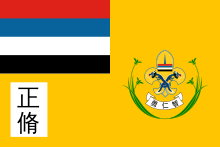Boy Scouts of Manchukuo
| 滿洲國童子團聯盟 | |||
|---|---|---|---|
 the top text reads "大滿洲帝國童子軍聯盟" (The Boy Scouts Alliance of the Empire of Great Manchuria); the bottom text reads "智、勇、仁" (Wisdom, Courage, Benevolence) | |||
 1930s Manchurian Boy Scout flag-the central design has two dragons crossing in an "x" pattern[1] | |||
| Country | Manchukuo | ||
| Founded | September 1932[2]/May 6, 1934 | ||
|
| |||

   | |||
The Boy Scouts of Manchukuo (Chinese: 滿洲國童子團聯盟 Mǎnzhōuguó Tóngzǐ Tuán Liánméng) was a Scouting association of Manchukuo. The Japanese military seized Manchuria in 1931, created the puppet government of Manchukuo in 1932, and controlled it until 1945. The Manchukuo government also set up Japanese-style Scouting in schools, which included para-military training.[3]
Background[]
In February 1937, Isamu Takeshita was appointed head of the Boy Scouts of Japan, the Sea Scouts, and the YMCA, as part of the general militarization of Japanese sports and athletics taking place at that time.[4] Japanese military authorities did not consistently encourage the Scouting movement in occupied territories. Where local conditions were favorable, authorities would permit local Scouting or introduce Japanese-style Scouting, or Shōnendan, and sometimes even made this compulsory. On the other hand, where conditions were not favorable, and anti-Japanese sentiments were likely to be nurtured through Scouting, the authorities would prohibit it entirely.[3]
Japanese military leaders banned Scouting for Chinese boys in occupied China by 1937, however they encouraged Japanese-style Scouting (少年團 Shōnendan) in Manchuria. In 1938 membership in the Concordia Shōnendan (協和少年團) was made compulsory for young people between 10 and 15 years old.[5] Alternately styled the Manchukuo Boys Corps, Manchuria Boy Scout Organization, and the Manchuria League of Boy Scouts,[6] the Scouts used the Scout motto of the existing Scouts of China, "智、勇、仁" (Wisdom, Courage, Benevolence), and Scout court of honor ceremonies were held at Confucian shrines.[7]
Emblem[]
The elaborate emblem incorporated the Flag of Manchukuo, as well as the dragons from the Manchu Qing Dynasty crossing in an "x" pattern. According to the Document of the Explanation of National Flag issued by the state council of Manchukuo on February 24, 1933, the colors on the flag represented the four directions and center.[8] The Study of Manchukuo National Flag published by state council of Manchukuo later also gave an representative based on Wu Xing.[9]
- Yellow represented the Center, symbolizes the rule of emperor of four directions and virtue of Ren in Confucianism, also Earth in Five Elements
- Red represented the South, symbolizes passion and courage, also Fire in Five Elements
- Blue represented the East, symbolizes youthfulness and holiness, also Wood in Five Elements
- White represented the West, symbolizes purity and justice, also Gold in Five Elements
- Black represented the North, symbolizes will and determination, also Water in Five Elements[10]
The colors also represented the five major peoples in Manchukuo:
- Yellow represented the Manchu people
- Red represented the Japanese (Yamato) people
- Blue represented the Han Chinese
- White represented the Mongol people
- Black represented the Korean people
Russian Scouting in China and Manchuria 1922–1947[]
Russian Scouts fleeing Bolshevism followed White Russian émigrés from 1917 to 1922 through Vladivostok to the east into Manchuria and south into central China, where very large groups of Russian Scouts came into being in cities such as Harbin, Tientsin and Shanghai.[11][12]
See also[]
References[]
- ^ "滿洲國童子團聯盟 – Facebook". www.facebook.com.
- ^ "老家綏中(63)「王道樂土」滿洲國統治下的綏中:協和會".
- ^ a b War and Occupation, 1941–1945 by Paul Kua, Deputy Chief Commissioner (Management), Scout Association of Hong Kong, 2010
- ^ Abe, Ikuo, Kiyohara, Yasuharu, and Nakajima, Ken. "Sport and physical education under fascistization in Japan", Bulletin of Health and Sport Sciences, University of Tsukuba, 13, 1990, pp. 25–46.[1]
- ^ Scouting in Hong Kong, 1910–2010 by Paul Kua, Scout Association of Hong Kong, 2011 ISBN 9627835692, 9789627835691
- ^ Nationality, Gender and Class, Author: Liu Jinghui 2017-03-13 Chapter Three Youth Policy and Youth in Manchukuo: One Patriotic youth's struggle against Japan and saving the nation; Two Establishment of the Manchuria Boy Scouts; Chapter Seven Data on adolescents and adolescent education in Manchuria: 1 Manchuria Boy Scout Organization; 2 Manchuria League of Boy Scouts[permanent dead link]
- ^ http://apjjf.org/-Suk-Jung-Han/1885/article.html Imitating the Colonizers: The Legacy of the Disciplining State from Manchukuo to South Korea, Suk-Jung Han July 6, 2005 Volume 3 | Issue 7
- ^ 对国旗意义的解释文件, State council of Manchukuo, February 24, 1933
- ^ "国立国会図書館デジタルコレクション – 新国家大満洲". dl.ndl.go.jp.
- ^ 貴志俊彦著『満洲国のビジュアル・メディア―ポスター・絵はがき・切手』、吉川弘文館 22頁、ISBN 978-4642080361
- ^ "NATIONAL ORGANISATION OF RUSSIAN SCOUTS NORS in China, 1922–1947". PineTree.web. Retrieved 2008-10-24.
- ^ Kroonenberg, Piet J. (1998). The Undaunted- The Survival and Revival of Scouting in Central and Eastern Europe. Geneva: Oriole International Publications. p. 83. ISBN 2-88052-003-7.
- Youth organizations established in 1932
- Scouting and Guiding in China
- Scouting in Japan
- Manchukuo
- Scouting stubs
- Chinese history stubs